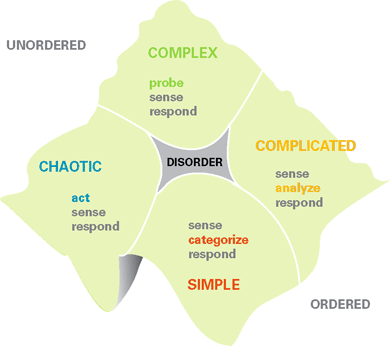This post is the eleventh post in my series on Sensemaking. The previous posts focus on how we can align and become sensemakers in working with our customers. This will focus on how we look at our own organizations.
For links to the other posts in the series, go to: Sensemaking, The Big Issue Facing Both Our Customers And Us.
As a reminder, I’ve posted a copy of the Cynefin model below.

The model provides us a framework to assess our organization and how we best address our challenges and problems, based on which quadrant we find ourselves in.
I won’t review the characteristics of each quadrant, or the Sensemaking methodology we apply in each quadrant. The diagram provides an overview. Also, earlier in this series, I went through each quadrant–from the customer perspective. The principles outlined there are the same principles we would apply in our own organizations.
Building on those capabilities, there are a few key points:
When we look at our own organization or function, in isolation, we may, mistakenly put them in the Simple or Complicated quadrants. For example, we may have had a very stable set of target customers, a well defined structure and go to market approach, and we keep just keep doing what we’ve always done. Stated differently, we’re happily working in our silos without needing to change.
Unfortunately, we find the world, consequently our businesses, don’t work in siloed domains–at least effectively. We are dependent on other parts of the organization and they are dependent on us. As a result, what used to work is no longer working as effectively as before.
More importantly, our customers force changes on what we do, how we do it. Being able to support them, creates problems and challenges we haven’t seen before.
Overlay on all of this, the “turbulence” I outlined in the very first post in this series. Few of us are not impacted by turbulence, as a result, increasingly we are finding our functions and enterprises moving into the Complex domain.
For many of us, facing severe disruption of our markets, severe disruption of our organizations (through mis-management, strategic errors, mergers, acquisitions, divestitures), we may find our organizations in the Chaotic domain.
Or more often, we find our organizations in Disorder–that is everyone has a different view of where we really are at, and we can resolve that difference. (And usually, when resolved, we probably find ourselves in the Complex domain.)
As we struggle to cope, as we try to figure out where we are at, then leverage the Cynefin principles to figure out how to respond, it’s important to understand the fundamentals.
We will be unable to respond or sustain our ability to respond without the fundamentals:
A clear purpose and everyone aligned around the purpose. Implicit in this purpose is a culture where everyone is aligned around the same values, everyone is committed to the same vision.
The organization, from the top leaders through the rest of the organization, must be obsessed with learning and continous improvement. But this learning is focused, it is tested an applied every day by everyone in execution, and drives another learning loop.
Individually and organizationally, we have to think in systems and frameworks. Cynefin is one set of frameworks that help us, there are many others like agile, lean, or problem solving methods that help us characterize and solve the problems we want. There are complementary Sensemaking tools we can leverage to help us understand and respond.
As individuals and organizations we have to increasingly become comfortable with being uncomfortable. We have to become comfortable with risk, uncertainty, ambiguity, dichotomy, paradox, change and adaptation.
At whatever level, we must recognize we cannot do this alone, we must leverage our teams, our colleagues in the organization, our partners, customers and suppliers. We will only be successful learning from each other and collaborating.
Most of all, we must recognize the tendency to become complacent, to not recognize the change and disruption around us. We must avoid becoming prisoners of our own experience.
We have the tools to help us understand and deal with these things. But without leadership, we will never understand or respond.
Tomorrow, I will wrap up this series. Sensemaking, at least initially, is very difficult to understand. It’s difficult to wrap our minds around how we leverage it to drive our own strategies, and how we innovate value with our customers. In the final post, hopefully, I can start to help you make Sense of Sensemaking.



